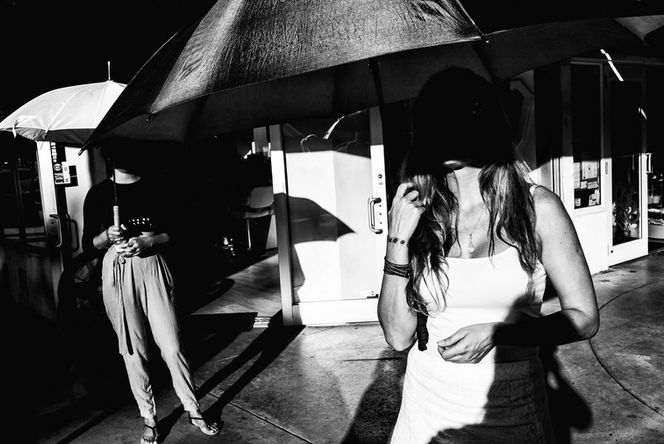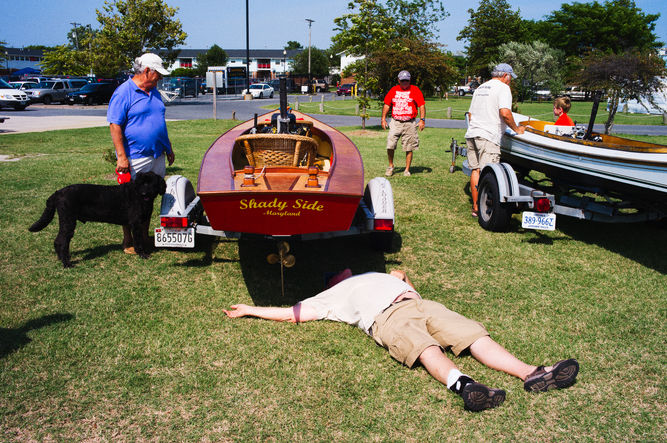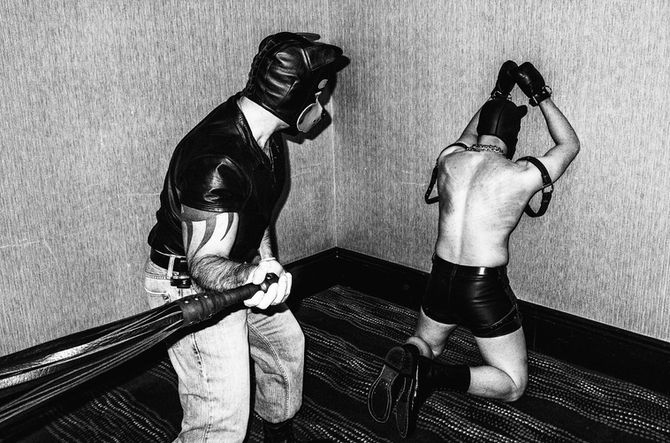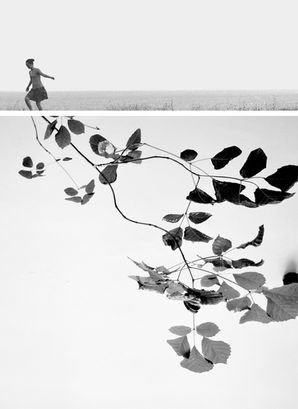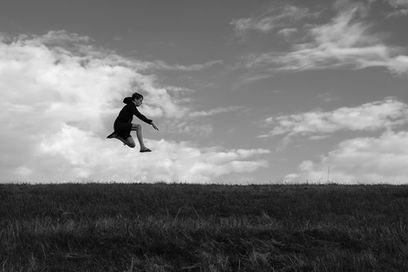
GRATUITY INCLUDED
October 9, 2020
INTERVIEW
PHOTOGRAPHY Chris Suspect
INTERVIEW Melanie Meggs
Chris Suspect is an acclaimed street and documentary photographer whose work has been exhibited around the globe and has won numerous awards. His photography captures the absurd and profound moments in everyday life, as well as the results of his deep dives into various subcultures. He is currently the chairperson of the Focus on the Story Festival in Washington, DC, and a guest lecturer at StreetFoto San Francisco and Street Photo Milano. His work has been published in the form of a book titled Suspect Device, which is held in the Leica Galerie Archives. In this interview, we delve into Chris Suspect's relationship with photography and uncover the stories that have shaped his approach to the craft. We explore the creative processes that inform his work, the events and experiences that inspire him, and the impact photography has had on his life and career.

“Photography has literally taken me around the world. My first publication, Suspect Device, in 2014, brought me to Photokina in Germany where my work was included in a massive exhibit on music photography. This was part of Leica’s presence at Photokina, and they flew me to Germany to participate. While there, I shared my work with several German gallerists, and those connections brought me to Tbilisi, Georgia, for an exhibit of the same work as part of the Kolga Tbilisi Photo Festival. While this was going on I was also entering my street photography work into several street photography competitions in Miami, San Francisco, London, Brussels, etc. I often was a finalist in these events and over time I have been asked to present my work in these locations. All of this served as a springboard to other opportunities, which led me to Romania, Italy, the Middle East, etc.
It’s been a nice and surprising journey.”
IN CONVERSATION WITH CHRIS SUSPECT
THE PICTORIAL LIST: Chris please tell us more about yourself. What led you to photography?
CHRIS SUSPECT: I am from Hyattsville, MD, just over the border of Washington, D.C. While the DC area has been my home for most of these years, I have lived in Moscow, Bangkok and Copenhagen. In addition to being a photographer, I am also a musician, video producer and podcaster.
My interest in photography started in my early 20s. I was not a photographer at that time but a bass player for a punk band called The Suspects. I used to go to the library to browse photo books and then make copies of the photos I liked for band flyers. I was primarily interested in war and crime photography because these kinds of graphic images lend themselves to great promotional posters for the kind of music we played.
Fast forward 15 years and I wound up getting my first point and shoot camera to document the birth of my son. I read the manual and would go out on my own and try to see what I could do creatively with the camera settings. I had no idea I was doing “street photography” at the time, I was really looking to recreate the style of images I used for flyers many years ago.
After some positive feedback on Flickr, many stolen images by bloggers, and requests by a few magazines, I decided to get more serious and started to pursue photography by enrolling in a colour photography class as a continuing education student at the Corcoran School of the Arts and Design.
TPL: What excites you about the photography you are creating?
CS: Ultimately what inspires me is that I do photography for myself. When I started out I told myself I did not want to do photography for money or earn a living off of it. In the past, I have started many creative ventures, for example music publishing, videography, and podcasting, that have turned successful and have become a job. Meaning, I started doing work for clients. What ultimately happens in each case is that I found myself doing work more for the money than for the sake of doing the work itself. This sucks the passion for it right out of the process for me.
I think by not caving in to the lure of financial gain, I have been able to maintain my passion for my photographic work. It doesn’t matter if I make money or not. That is not what photography is about for me.
Just the ability to create what I want to create, whether successful or not, is what keeps me going and still excites me to this day.
TPL: How do you choose your subjects and your projects? Also tell us a bit about your two previous published books?
CS: Almost everything for me begins with a serendipitous act. Often I don’t choose a project, it finds me. For example, I have a body of work called Faith that explores gay African Americans and their relationship with religion. This came about by witnessing a car accident in Washington, D.C. I photographed the scene and gave copies of the images to the person who was hit by the car. Months later this person called me up and asked me to shoot a party. Knowing he was black and gay I thought it could be interesting, as I had never been to a party like that before. This experience opened up a whole new world to me that eventually led me to shooting underground African American Baptist Church services.
Going to Romania for the VSLO photography and visual arts festival is what led to working on “Old Customs.” I wasn’t planning on starting a project when I went there, but once I got interested in their youth culture I just kept pulling on those threads and pursuing it, doing my best to make sense of what I was doing.
At the start of 2020 I made a New Year’s resolution to publish 4 books, 1 for each quarter of the year. Old Customs is book number 3. The previous books are Gratuity Included, a collection of wild party-type photos from over the past 8 years that reads like a fever dream or an Alice in Wonderland-type sequence, and Leather Boyz, a deep dive into the gay BDSM culture in Washington, DC. The fourth book will likely be a return to my roots with an emphasis on music photography. All of these other books are black and white. Old Customs is the only one in colour.
TPL: What was the process of getting the people in Vama Veche to be open to you photographing them? Can you describe your creative process in your project/book OLD CUSTOMS that you shared in our stories?
CS: A lot of photographs in the book are straight street photography style observations, so I basically just shot freely, like I do in any public space situation. Unlike a lot of countries in Europe, Romania seems more open to candid photography.
As far as the conceptual mirror shots go, that came about by meeting people through the photography festival I attended and who were open to my ideas. There are a couple of exceptions where I just met people on the beach or in the town and they were willing to be part of the project.
What’s interesting is when I share an image of a mirror shot from my phone, people become really intrigued and open up to the idea of being a subject. It helps that you do not see the person’s face so it allows for anonymity as well.
TPL: Do you have a favourite quote/lyric/saying that resonates with you the best?
CS: Yes I do! The quote is, “In the fields of observation chance favours only the prepared mind.” This was said by Louis Pasteur, the great French biologist, chemist and microbiologist.
Even though he is referring to the process of scientific discovery it also applies to the art of photography. How do you prepare your photographic mind? You take classes, you read photo books, you study the masters, etc. Having all of this photographic history and knowledge in the back of your mind while you are out shooting helps you to better identify interesting situations and challenges, things you may miss if you don’t study this sort of background material.
Once you get to this point, you can really start to develop your own unique visual identity or voice.
Just the ability to create what I want to create, whether successful or not, is what keeps me going and still excites me to this day.

TPL: What do you want to express through your photography? What are some of the elements you always try to include in your photographs?
CS: A lot of what I am trying to express is really dependent on the project or goal. For example “Old Customs” is partly about expressing the feeling of freedom. However, there are numerous photographic tropes and elements that I often return to or explore.
One of these is trying to have the viewer feel as if they too are in the midst of the action. I like to get close and I want the viewer to be part of it. Another is humour, I am a sucker for visual puns and juxtapositions. I think gestures can be very telling. And light is very important. I always try to consider the role and meaning of light (or lack of it) in my images to convey a feeling or an intentional interpretation I want to bestow on the viewer.
TPL: Do you have any favourite artists or photographers you would like to share with us, and the reason for their significance?
CS: I am inspired by many different photographers and artists, from Lee Friedlander and Dawoud Bey to Barbara Kruger and Jeff Wall. All of them have opened my eyes to different approaches and techniques. I often “borrow” or reinterpret ideas from various photographers from time to time depending on my end goals.
For my black and white work I am definitely inspired by people like Weegee, Anders Petersen, Larry Fink, Daido Moriyama, and Robert Frank. In my colour work I often look to folks like Joel Sternfeld, Alex Webb, Harry Gruyaert and Ryan McGinley.
TPL: Has your style of shooting changed since you first started?
CS: I don’t know if it has changed as much as it has been refined. I first gained notice as a music photographer, then as a street photographer and documentarian. I have since moved on to personal diary type work and I am now exploring ideas of conceptual work.
I think all of these genres or styles for me still contain the principal elements of my photographic voice. They just get adapted to the genre I am shooting in. If you study the work of Lee Friedlander you will notice his particular viewpoint weaves itself through a wide variety of styles, from street photography to landscapes and nudes. The same holds true for numerous other photographers that have had a long and varied career.
TPL: How does the equipment you use help you in achieving your vision in your photography? Do you have a preferred lens/focal length?
CS: I have two cameras that I have stuck with throughout the years, mainly for their form and image quality. I have a Leica MP and Ricoh GR II. And, I usually stick with a 35mm or 28mm focal length depending on what I am shooting.
Both the Leica and Ricoh are unassuming cameras. I always use my Leica during the day and sometimes at night when I know I am going to be shooting something with purpose. The Ricoh I often take with me at night when I have no real plans. It’s just super handy and can produce fantastic images with the on camera flash aesthetic you see in a lot of Japanese street photography and fashion photography from the 90s and 2000s.
As far as focal length goes I use the 35mm during the day and the 28 mm for when I am in close quarters and want to capture as much of the scene as possible.
TPL: What are some of your goals as an artist? Where do you see yourself or hope to see yourself in five years?
CS: Once the COVID-19 nightmare is over I’d like to return to shooting and travelling more. This has really been a tough year for me photographically as all of my work involves people. I have been thinking about what I’d like to explore and I have some ideas of what I’d like to pursue. But for now my main goal is working on this current books project.
I hope the ground work that I am laying in 2020 with these publications will offer me more opportunities in the future for exhibits, travel and workshops. I also have a few more book ideas that I already have content for.
So essentially in five years I hope to be doing more of the same while broadening my photographic practices.
TPL: “When I am not out photographing, I (like to)…
CS: I love cooking so I am always working on new recipe ideas and food combinations. I also enjoy playing music with friends and neighbours. And, I am a fitness freak to some extent. I exercise almost everyday, whether running or lifting weights."

